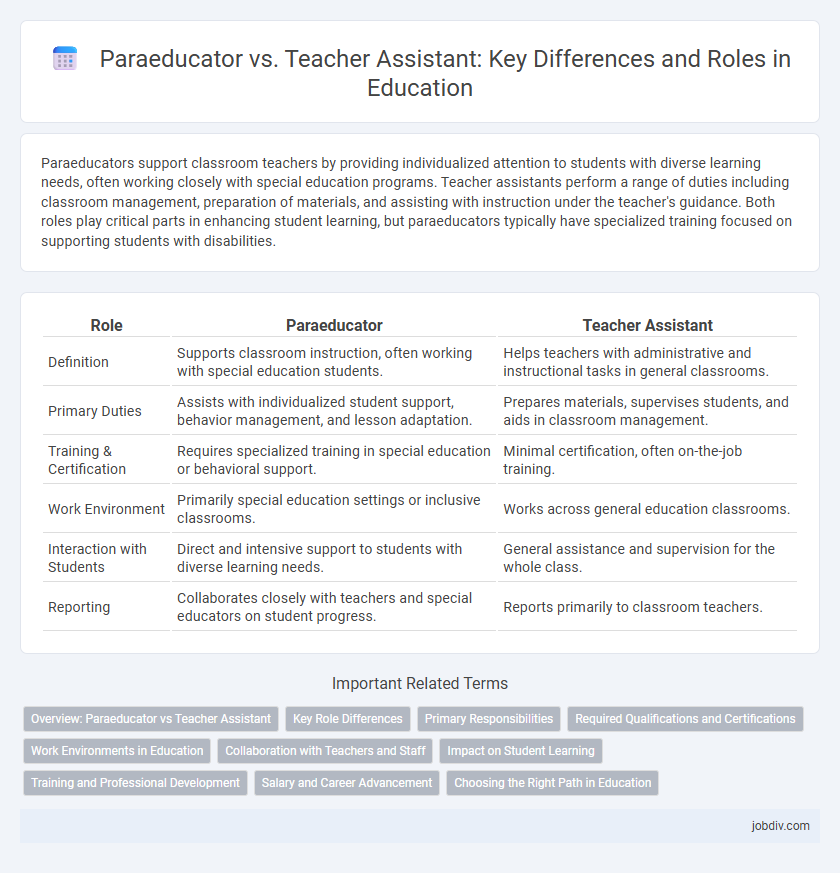Paraeducators support classroom teachers by providing individualized attention to students with diverse learning needs, often working closely with special education programs. Teacher assistants perform a range of duties including classroom management, preparation of materials, and assisting with instruction under the teacher's guidance. Both roles play critical parts in enhancing student learning, but paraeducators typically have specialized training focused on supporting students with disabilities.
Table of Comparison
| Role | Paraeducator | Teacher Assistant |
|---|---|---|
| Definition | Supports classroom instruction, often working with special education students. | Helps teachers with administrative and instructional tasks in general classrooms. |
| Primary Duties | Assists with individualized student support, behavior management, and lesson adaptation. | Prepares materials, supervises students, and aids in classroom management. |
| Training & Certification | Requires specialized training in special education or behavioral support. | Minimal certification, often on-the-job training. |
| Work Environment | Primarily special education settings or inclusive classrooms. | Works across general education classrooms. |
| Interaction with Students | Direct and intensive support to students with diverse learning needs. | General assistance and supervision for the whole class. |
| Reporting | Collaborates closely with teachers and special educators on student progress. | Reports primarily to classroom teachers. |
Overview: Paraeducator vs Teacher Assistant
Paraeducators and teacher assistants both support classroom instruction but differ in roles and responsibilities. Paraeducators often engage in specialized tasks such as providing individualized instruction to students with special needs, while teacher assistants primarily help with general classroom management and administrative duties. Understanding these distinctions helps schools allocate resources effectively to enhance student learning outcomes.
Key Role Differences
Paraeducators primarily provide instructional support by working directly with students under a teacher's guidance, often focusing on individualized learning and behavior management. Teacher assistants typically assist with classroom logistics, such as preparing materials, supervising students during non-instructional times, and supporting general class activities. The key role difference lies in the paraeducator's increased involvement in instructional delivery and personalized student support compared to the more administrative and supervisory duties of teacher assistants.
Primary Responsibilities
Paraeducators primarily support classroom teachers by assisting with instructional activities and providing one-on-one attention to students with special needs, ensuring individualized learning support. Teacher assistants often handle more clerical and routine tasks such as supervising students, preparing materials, and managing classroom behavior to maintain an effective learning environment. Both roles are essential but differ in the depth of instructional involvement and direct interaction with students' academic development.
Required Qualifications and Certifications
Paraeducators typically require a high school diploma or equivalent along with specialized training or certification in areas such as special education or instructional support. Teacher assistants often need similar qualifications but may also be required to complete state-specific certification programs or associate degrees in education. Both roles demand background checks and ongoing professional development to meet school district standards.
Work Environments in Education
Paraeducators commonly support students with special needs in inclusive classrooms, while teacher assistants often work in general education settings assisting with administrative tasks and classroom management. Paraeducators are frequently employed in specialized programs, such as special education or reading intervention, whereas teacher assistants are more likely found in elementary and secondary schools across a variety of subjects. Both roles collaborate closely with teachers but differ in their direct instructional responsibilities and the specific educational environments they serve.
Collaboration with Teachers and Staff
Paraeducators and teacher assistants play crucial roles in supporting classroom instruction by collaborating closely with teachers and staff to enhance student learning. They assist in implementing lesson plans, provide individualized attention to students, and communicate regularly with educators to address academic and behavioral needs. Effective teamwork between paraeducators, teacher assistants, and teachers ensures a cohesive educational environment that fosters student success.
Impact on Student Learning
Paraeducators and teacher assistants both support student learning but differ in responsibility and instructional impact; paraeducators often engage in specialized, one-on-one interventions for students with disabilities, enhancing individualized learning outcomes. Teacher assistants typically assist with classroom management and general instructional duties, contributing to a conducive learning environment but with less direct influence on curriculum delivery. Research indicates paraeducators with targeted training can significantly improve academic and behavioral progress for students requiring additional support.
Training and Professional Development
Paraeducators undergo specialized training programs focused on instructional support, behavior management, and student engagement, often requiring certification or state-mandated qualifications. Teacher Assistants typically receive on-the-job training tailored to classroom needs, with fewer standardized professional development requirements. Ongoing professional development for paraeducators emphasizes enhancing instructional strategies and compliance with educational regulations, while teacher assistants may pursue workshops and in-service training to support specific teacher-led activities.
Salary and Career Advancement
Paraeducators typically earn an average salary ranging from $25,000 to $35,000 annually, while teacher assistants can expect salaries between $28,000 and $38,000 depending on location and experience. Career advancement for paraeducators often involves pathways to becoming certified teachers through additional education, whereas teacher assistants may progress into specialized instructional roles or administrative support positions. Salary growth in both roles is influenced by certification levels, district budgets, and years of service in the education sector.
Choosing the Right Path in Education
Paraeducators provide targeted instructional support and classroom management under teacher supervision, focusing on individual student needs and special education. Teacher assistants help with routine classroom tasks, assisting the lead teacher in lesson preparation and student supervision, often requiring less specialized training. Choosing the right path depends on career goals, desired responsibilities, and qualifications, with paraeducators often requiring additional certifications for specialized roles.
Paraeducator vs Teacher Assistant Infographic

 jobdiv.com
jobdiv.com